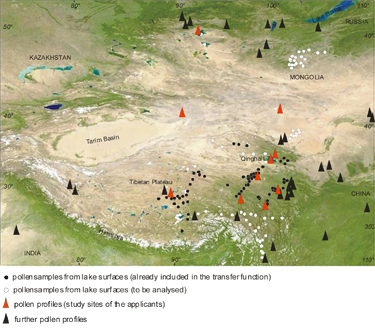|
Vegetation, climate, man – Holocene variability in monsoonal Central Asia
Principal Investigators: Ulrike Herzschuh (AWI Bremerhaven), Martin Claussen (MPI Hamburg), Steffen Mischke (FU Berlin)
Project Scientists: Jian Ni (AWI Bremerhaven), Anne Dallmeyer (MPI Hamburg)
Information on past terrestrial biomass changes are crucial to understand the global carbon cycle. Holocene pollen records of monsoonal Central Asia reveal that large-scale vegetation shifts from high-productive forests and steppes to low-productive semi-deserts and deserts occurred since the mid-Holocene. Whether these shifts have to be attributed to human agency or to climate change is uncertain to date. In this project, both proxy-record reanalysis and climate modelling studies will be applied to understand the relationships of Holocene vegetation, climate and pre-historic societies in monsoonal Central Asia (25-50°N; 70-110°E). Concerning proxy-data, our study design comprises (1) quantitative biome reconstruction from pollen data, (2) quantitative climate reconstruction through the application of pollen-climate transfer functions to fossil pollen records and (3) the compilation of non-vegetation records which provide information on moisture change. Model simulations will be performed by (4) prescribing the Holocene land-surface reconstructions for Central Asia and (5) by inclusion of an interactive vegetation model. (6) Different vegetation initial conditions will be used to investigate possible long-term effects of land-use.
Analyses of pollen, chironomids and ostracods, pollen- and chironomid-temperature/precipitation transfer functions, quantitative palaeovegetation reconstruction (biomisation), equilibrium and dynamic vegetation modelling, coupled climate-vegetation modelling.
Archives
Lake sediments, pollen, chironomid and ostracod records, archaeological records.
|
| Next > |
|---|


